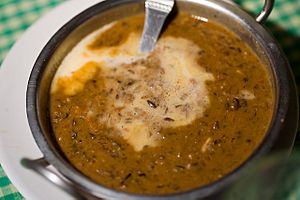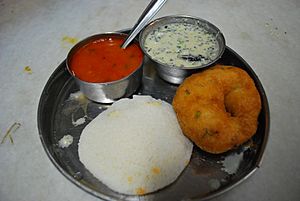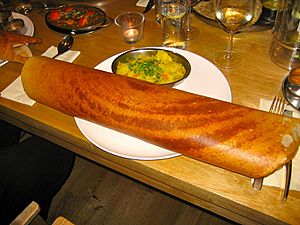Black gram facts for kids
Quick facts for kids Black gram |
|
|---|---|
 |
|
| Dry urad beans | |
| Scientific classification | |
| Genus: |
Vigna
|
| Species: |
mungo
|
| Synonyms | |
|
|
The black gram (scientific name: Vigna mungo) is a special type of bean grown mostly in South Asia. You might also hear it called urad bean, mungo bean, or black matpe bean. It's related to the mung bean. Sometimes, people call the whole black gram bean a "black lentil," but it's not the same as a true black lentil. If the bean is split in half, it looks white inside and is sometimes called a "white lentil."
Black gram has been grown in India for a very long time. It's one of the most important pulses (a type of bean or pea) in Indian cooking. Farmers grow it during both the summer (Kharif) and winter (Rabi) seasons. Places like Nagapattinam and Guntur in India are well-known for growing a lot of black gram. In Nepal, it's called kalo maas daal or kalo daal, and it's a popular side dish with curry and rice. Black gram has also traveled to other warm places like the Caribbean and Africa, often brought by people from India.
Contents
What Does Black Gram Look Like?
Black gram plants are usually upright or spread out, and they have lots of tiny hairs. They grow about 30 to 100 centimeters tall. The plant has a main root that branches out, with small, round bumps called nodules on the roots. These nodules help the plant take nitrogen from the air, which is good for the soil. The pods that hold the beans are thin and round, growing up to six centimeters long. Each plant has large, hairy leaves and seed pods that are about 4 to 6 centimeters long.
How People Use Black Gram in Cooking

Black gram is very popular in cooking, especially in India. In Northern India, people often use the whole or split beans to make a dish called dal. When cooked, it can have a unique, slightly sticky texture.
Black Gram in South Indian Dishes
In South India, black gram is a key ingredient for many famous foods.
- Idli and Dosa: It's mixed with rice to make the batter for idli (steamed rice cakes) and dosa (thin, crispy pancakes). Usually, one part black gram is mixed with three or four parts rice.
- Vada: Vada (or udid vada) are savory doughnuts made from soaked black gram batter and then deep-fried.
- Papadum: The dough from white lentils (split black gram) is also used to make papadum, which are thin, crispy flatbreads.
Black Gram in Other Indian Dishes
- In Punjabi cuisine, black gram is a main part of dal makhani, a creamy and rich lentil dish.
- In Bengal, it's used in a dish called biulir dal.
- In Rajasthan, people use it to make a type of dal that they often eat with bati, a baked bread.
Nutrition Facts About Black Gram
| Nutritional value per 100 g (3.5 oz) | |
|---|---|
|
58.99
|
|
| Sugars | 0 |
| Dietary fiber | 18.3 |
|
1.64 g
|
|
|
Protein
|
25.21
|
| Vitamins | Quantity
%DV†
|
| Thiamine (B1) |
24%
0.273 mg |
| Riboflavin (B2) |
21%
0.254 mg |
| Niacin (B3) |
9%
1.447 mg |
| Pantothenic acid (B5) |
0%
0.0 mg |
| Vitamin B6 |
22%
0.281 mg |
| Folate (B9) |
157%
628 μg |
| Choline |
0%
0 mg |
| Vitamin C |
0%
0 mg |
| Vitamin E |
0%
0 mg |
| Vitamin K |
0%
0 μg |
| Minerals | Quantity
%DV†
|
| Calcium |
14%
138 mg |
| Iron |
58%
7.57 mg |
| Magnesium |
75%
267 mg |
| Manganese |
0%
0 mg |
| Phosphorus |
54%
379 mg |
| Potassium |
33%
983 mg |
| Sodium |
3%
38 mg |
| Zinc |
35%
3.35 mg |
| Other constituents | Quantity |
| Water | 10.8 |
|
Link to USDA Database entry
|
|
| †Percentages estimated using US recommendations for adults. | |
Black gram is very healthy and full of good things for your body!
- It has a lot of protein (about 25 grams in every 100 grams). Protein helps your body grow and repair itself.
- It's rich in potassium (983 mg/100g), which is important for your heart and muscles.
- You'll also find good amounts of calcium (138 mg/100g) for strong bones, and iron (7.57 mg/100g) which helps carry oxygen in your blood.
- It also contains important vitamins like niacin, thiamine, and riboflavin, which help your body use energy.
- Black gram is especially high in folate (628 micrograms/100g when raw), a vitamin important for healthy cell growth.
Because it has so many nutrients, black gram is a very important food for people in India and Nepal, helping them get the essential nutrients they need.
Different Names for Black Gram
Vigna mungo has many different names depending on where you are in South and Southeast Asia. Many of its names in India come from an old language called Proto-Dravidian.
Here are some of its names:
- Caribbean Hindustani/Fiji Hindi: उरदी दाल urdi dal
- Gujarati: અળદ aḷad, અડદ aḍad
- Punjabi: ਮਾਂਹ ਦੀ ਦਾਲ, "mānha di dāl"
- Hindi: उड़द दाल uṛad dāl, उरद दाल urad dāl
- Kannada: ಉದ್ದು uddu, ಉದ್ದಿನ ಬೇಳೆ uddina bēḷe
- Marathi/Konkani: उडीद uḍid
- Malayalam: ഉഴുന്ന് uẓunu
- Tamil: உளுந்து uḷuntu, ulundu, ulutham paruppu
- Telugu: మినుములు minumulu and Uddhi Pappu in Rayalaseema
- Tulu: urdu bele
- Urdu: اورد دال urad dāl
Some names come from the Sanskrit word masa:
- Assamese: মাটিমাহ matimah, মাটিকলাই matikolai
- Bengali: মাসকালাই ডাল mashkalai ḍal
- Nepali: Kalo Daal (black lentil), मास mās
- Punjabi: دال ماش dāl māsh
Other names include:
- Odia: ବିରି ଡାଲି biri ḍāli
- Sinhala: උඳු undu
- Myanmar: မတ်ပဲ matpe
- Vietnamese: đậu muồng ăn
Types of Black Gram Plants
Scientists and farmers have developed different types of black gram plants over the years. These types might grow better in certain conditions or have different qualities. Some examples include:
- Pant Urd 31 (PU-31)
- Lam Black Gram 884 (LBG 884)
- Trombay Urd (TU 40)
- Pant U-13
- JU-2
- Type-9 (This was the first urad bean type developed in 1948!)
- Barkha
- Gwalior-2
- Mutant varieties: CO-1 and Sarla
- Spring season varieties: Prabha and AKU-4
See also
 In Spanish: Fréjol negro para niños
In Spanish: Fréjol negro para niños



